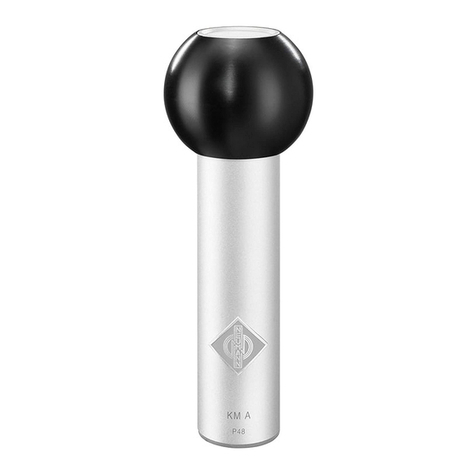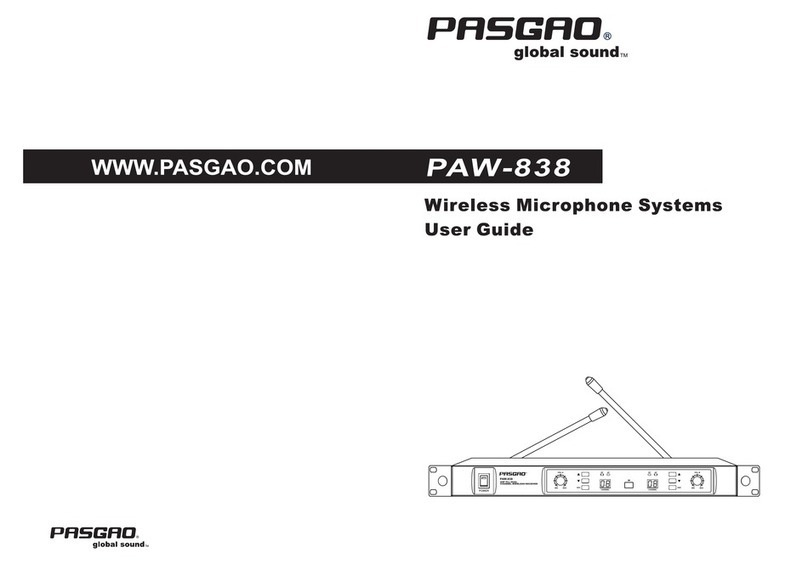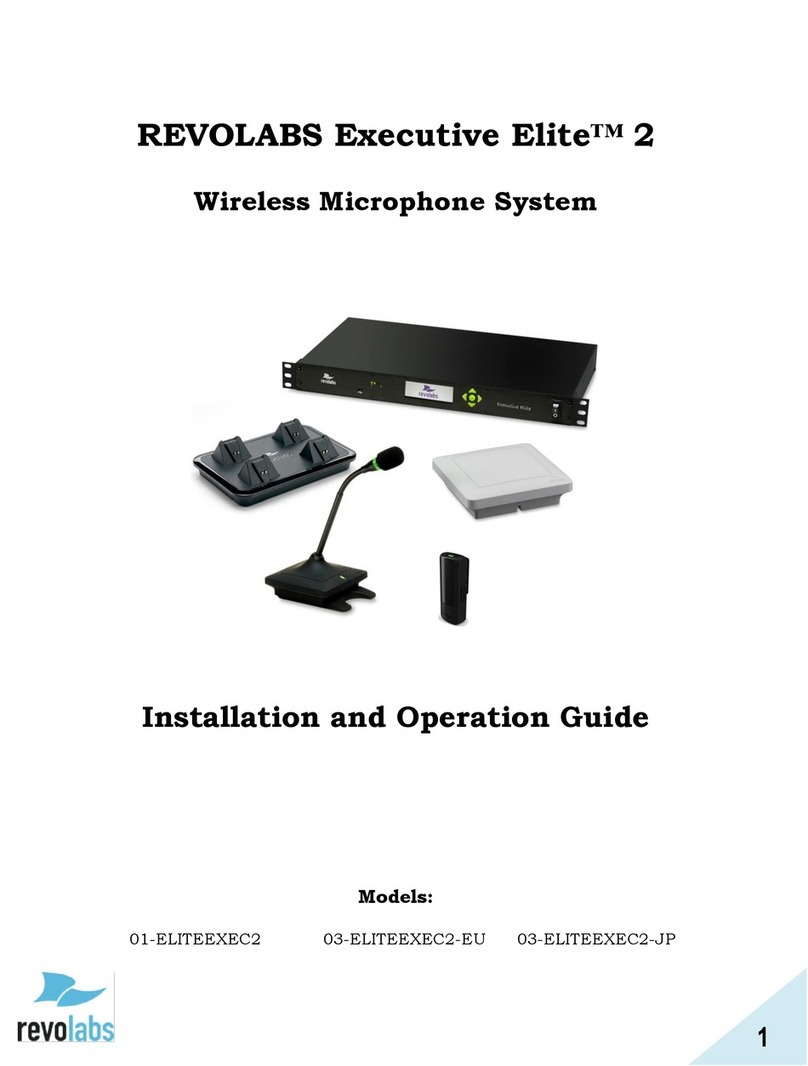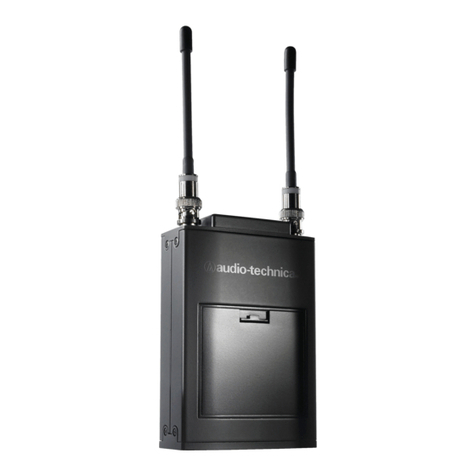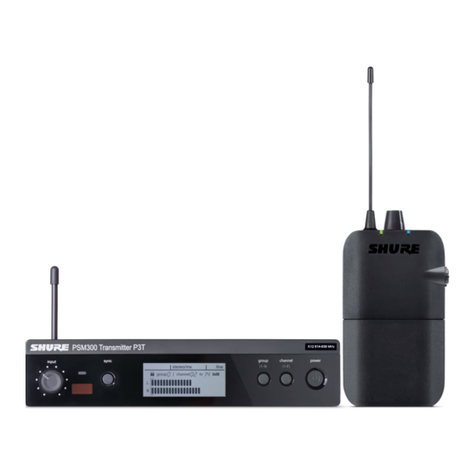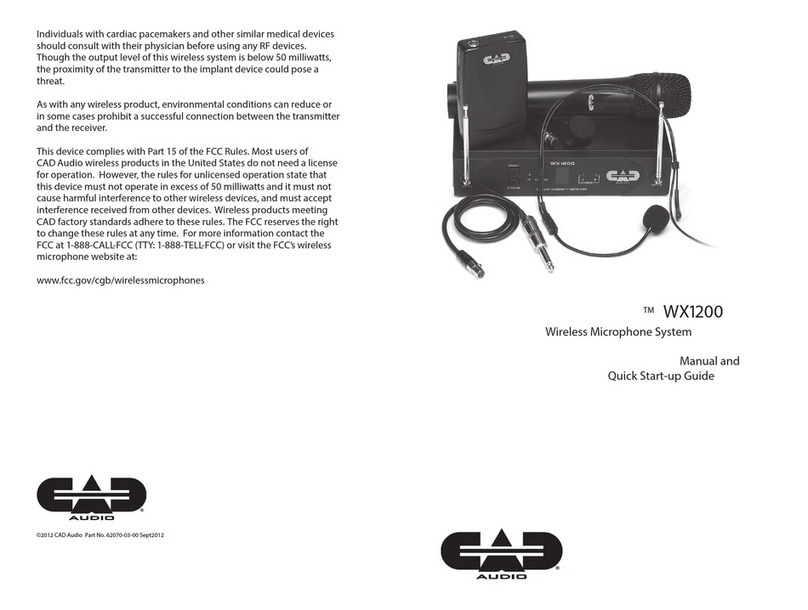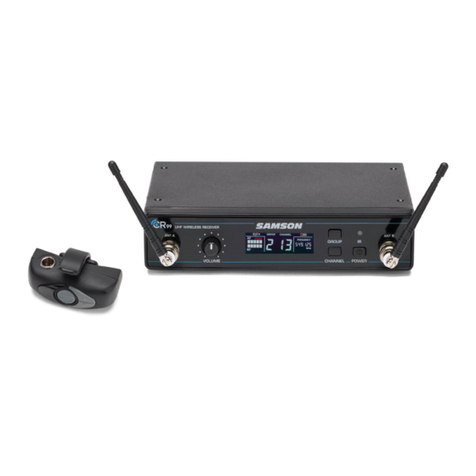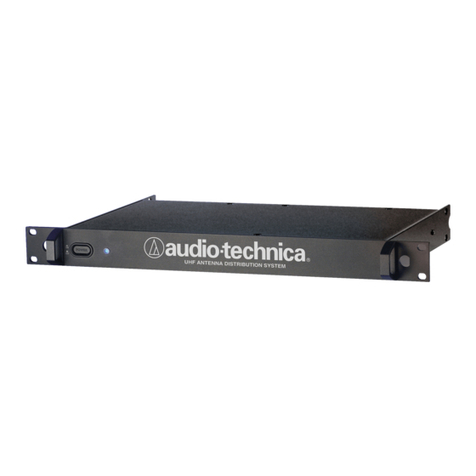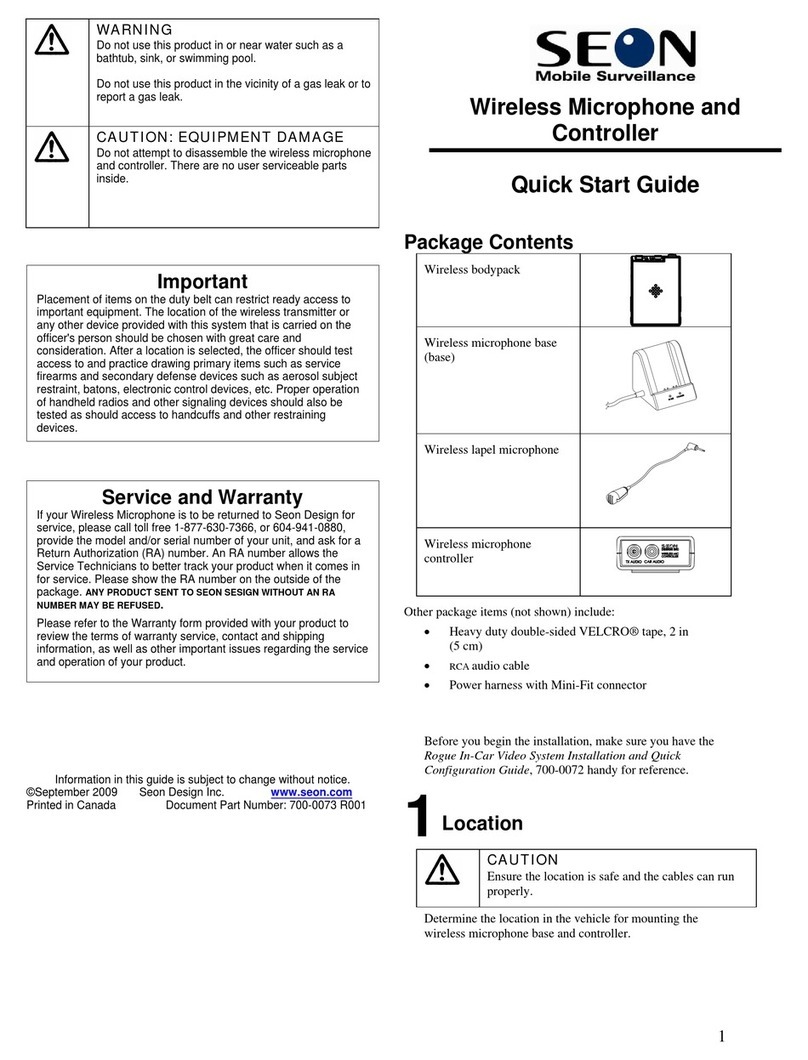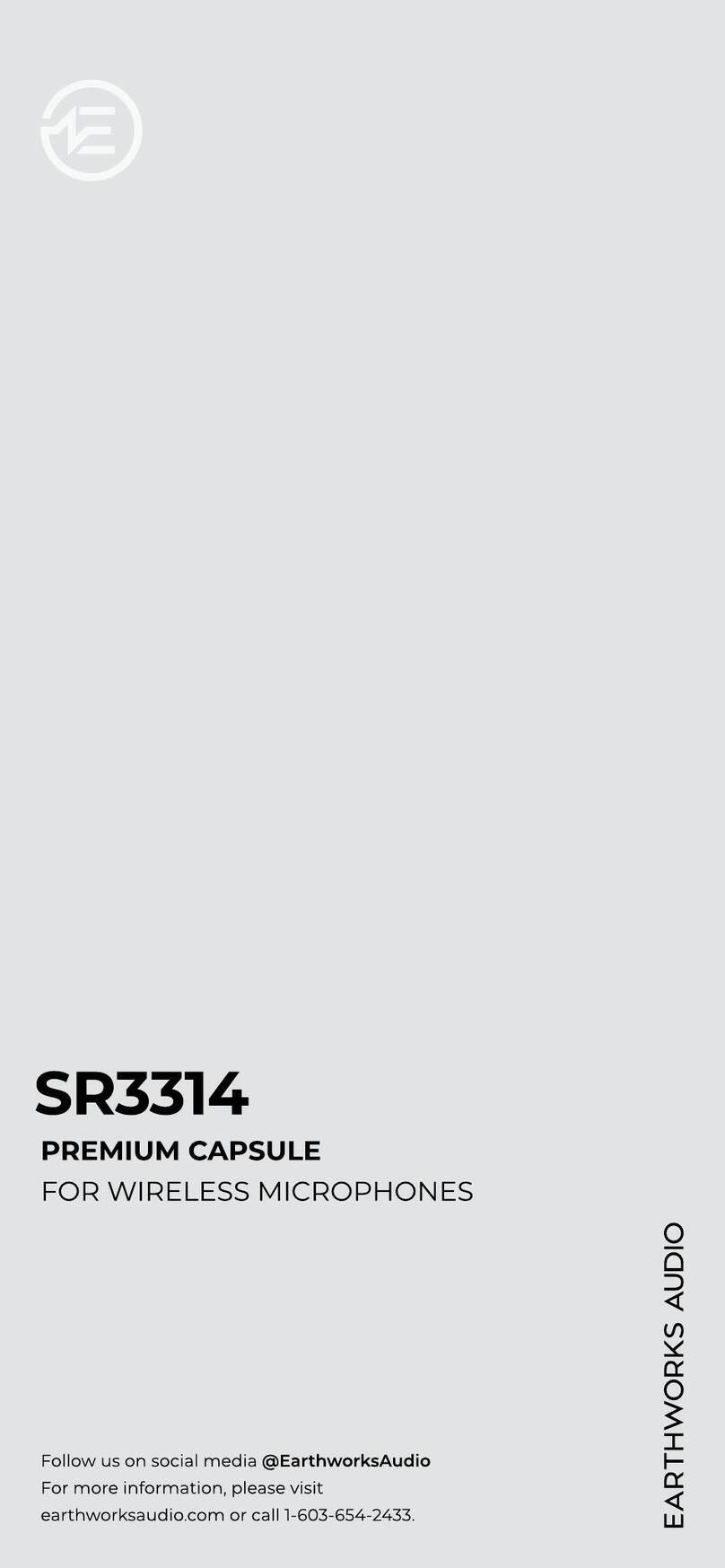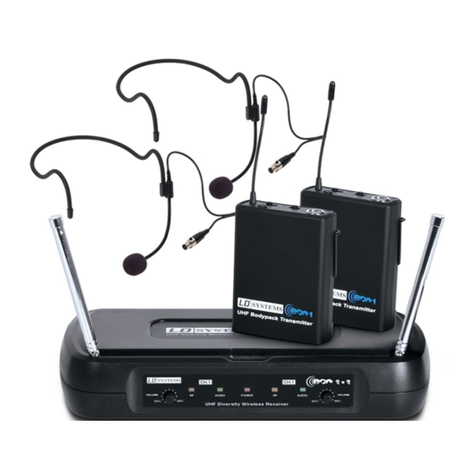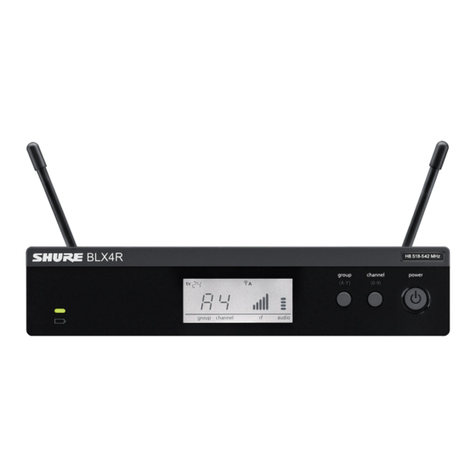Neumann.Berlin DMI-8 User manual

· . · ·
()/- · - · @. · ..
DMI-
B
O M
Registrieren Sie bitte Ihr
System auf der Website
www.my-Solution-D.com,
um über Updates informiert
zu werden!
Please register your system
on the website
www.my-Solution-D.com,
to be informed whenever updates
are available!

2
D3D
1. Einleitung
In dieser Anleitung finden Sie alle wichtigen In-
formationen für den Betrieb und die Pflege des
von Ihnen erworbenen Produktes. Lesen Sie diese
Anleitung bitte sorgfältig und vollständig, bevor
Sie das Gerät benutzen. Bewahren Sie die Anlei-
tung bitte so auf, dass sie für alle momentanen
und späteren Nutzer jederzeit zugänglich ist.
Weitergehende Informationen, insbesondere
auch zu den verfügbaren Zubehörteilen und den
Neumann-Servicepartnern, finden Sie auf unserer
Website www.neumann.com. Die Servicepartner
können Sie auch telefonisch unter +49 (0) 30 /
41 77 24 – 0 erfragen.
Auf unserer Website www.neumann.com finden
Sie in der Rubrik Downloads/Solution-D ergän-
zend folgende Dateien:
• Bedienungsanleitung und Firmware der digi-
talen Mikrophone (D-01, KM D, TLM 103 D ...).
• Bedienungsanleitung und Firmware der digi-
talen Mikrophoninterfaces (DMI-2, DMI-8 …)
• Fernsteuersoftware (RCS) und zugehörige Be-
dienungsanleitung
• Kurzbeschreibung des AES42-Standards
Weitergehende Informationen zur Schnittstelle
digitaler Mikrophone finden Sie bei www.aes.org/
standards unter „AES standard for acoustics – Di-
gital interface for microphones“.
Zum weltweiten Erfahrungsaustausch unter
Neumann-Anwendern bieten wir das Neumann
Online-Forum an, das sich durch die integrierte
Archivfunktion zu einem umfangreichen Know-
How-Pool entwickelt hat.
2. Sicherheitshinweise
Das Digitale Mikrophon-Interface DMI-8 dient
der Speisung und Fernsteuerung digitaler Mikro-
phone nach dem internationalen Standard AES42
und der Bereitstellung des Mikrophonsignals im
AES/EBU-Format.
• Schließen Sie an die Eingänge nur Mikrophone
an, die dem Standard AES42 entsprechen.
• Beim Anschluss anderer digitaler Signalquel-
len mit AES3- bzw. AES/EBU-Ausgängen muss
die zur Speisung digitaler Mikrophone dienen-
de Phantomspeisung (DPP – Digital Phantom
Power) abgeschaltet sein.
• Verbinden Sie die Ausgänge nur mit korrespon-
dierenden Eingängen der angeschlossenen Ge-
räte.
Die RJ-45-Buchsen – CONTROL BUS (RS 485)
und GN OUT – tragen Gleichspannung und
dürfen nicht an ein Ethernet angeschlossen
werden.
Reparatur- und Servicearbeiten dürfen nur
von erfahrenem und autorisiertem Fachper-
sonal durchgeführt werden. Wenn Sie die
Geräte eigenmächtig öffnen oder umbauen,
erlischt die Gewährleistung.
• Lassen Sie das Gerät auf Umgebungstempera-
tur akklimatisieren, bevor Sie es einschalten.
• Nehmen Sie das Gerät nicht in Betrieb, wenn es
beschädigt ist.
• Verlegen Sie Kabel stets so, dass niemand dar-
über stolpern kann.
• Halten Sie Flüssigkeiten und elektrisch leitfä-
hige Gegenstände, die nicht betriebsbedingt
notwendig sind, von den Geräten und deren
Anschlüssen fern.
• Verwenden Sie zum Reinigen keine Lösungs-
mittel oder aggressiven Reinigungsmittel.
• Entsorgen Sie die Geräte nach den Bestimmun-
gen Ihres Landes.
Allgemeiner Hinweis: Alle zu Mikrophonen ge-
machten Angaben beziehen sich auf digitale Mi-
krophone der Solution-D-Serie von Neumann.
Haftungsausschluss:
Die Georg Neumann GmbH übernimmt keinerlei
Haftung für einen Gebrauch des Produkts, der
von den in der Bedienungsanleitung genannten
technischen Voraussetzungen abweicht (z.B.
Bedienungsfehler, falsche Netzspannung). Dies
gilt auch dann, wenn auf mögliche Schäden bei
abweichendem Gebrauch hingewiesen wurde.
Jegliche Geltendmachung von Schäden und Folge-
schäden, die dem Benutzer aufgrund eines nicht
bestimmungsgemäßen Gebrauchs entstehen,
wird ausgeschlossen. Ausgenommen von diesem
Haftungsausschluss sind Ansprüche aufgrund des
Produkthaftungsgesetzes.
3. Beschreibung
Das DMI-8 ist ein Speise- und Steuergerät für di-
gitale Mikrophone, die nach dem Standard AES42
arbeiten (www.aes.org).
Die wichtigsten Eigenschaften des DMI-8 sind:
• Speisung und Fernsteuerung von 8 digitalen
Mikrophonen gemäß Standard AES42
• Empfang und Verarbeitung der Audiodaten vom
Mikrophon
• Erzeugung von Ausgangssignalen im AES/EBU-,
ADAT- und GN-Format
• Synchronisation der Mikrophone auf den
Wordclock des DMI-8 gemäß AES42-Standard
Mode 2 (siehe Kapitel 7.4 Synchronisation)
• Automatische Synchronisation des DMI-8 auf ein
externes Synchronisationssignal (Wordclock
oder AES11)
• Unterstützung aller üblichen Abtastraten:
44,1 / 48 / 88,2 / 96 / 176,4 / 192 kHz.
• Computerschnittstelle – Control Bus (RS 485) –
zur Durchleitung und Verarbeitung bidirektio-
naler Steuerdaten. Neumann stellt für diesen
Zweck eine Steuersoftware für PC und Mac
(Remote Control Software – RCS) zur Verfü-
gung.
• User Port zur direkten Steuerung (Schaltkon-
takt bzw. Aktiv-Low-Signal) ausgewählter
Funktionen (Mute, LED1, LED2)
• Mehrere Geräte können kaskadiert werden
(DMI-8 or DMI-2).
• Alle Einstellungen der angeschlossenen Mi-
krophone bleiben im stromlosen Zustand des
DMI-8 erhalten. Nach dem Wiedereinschalten
werden diese Einstellungen über den Fernsteu-
erdatenstrom in die Mikrophone übertragen,
auch ohne dass eine Verbindung zum Computer
besteht.
Anzeigen (Abb. 1)
POWER
Anzeige der Betriebsbereitschaft. Während des
Startvorgangs leuchtet die Anzeige mit redu-
zierter Helligkeit.
VALID
Anzeige eines gültigen AES42-Datenstroms vom
Mikrophon zum DMI-8. Die Anzeige blinkt, wäh-
rend das Mikrophon synchronisiert wird. Sie
leuchtet durchgehend, wenn ein gültiger Daten-
strom empfangen wird und das Mikrophon erfolg-
reich synchronisiert ist.
LEVEL
Peak-Level-Anzeige (Multicolor LED) des Mikro-
phonsignals:
• Aus: kleiner –60 dBFS
• Grün: –60 dBFS bis –12 dBFS
• Orange: –12 dBFS bis –1,5 dBFS
• Rot: größer –1,5 dBFS
EXT WCLK
Anzeige eines externen Synchronisationssignals
am WORD CLOCK (OR AES11)-Eingang. Die Anzei-
ge ist aus, wenn kein externes Synchronisations-
signal erkannt wird. Die Anzeige blinkt, wenn ein
Synchronisationssignal anliegt, aber noch keine
Synchronisation erreicht ist. Die Anzeige leuchtet
durchgehend, wenn das DMI-8 erfolgreich syn-
chronisiert ist. Ein dauerhaftes Blinken der Anzeige
bedeutet, dass ein ungültiges Synchronisations-
signal am DMI-8 angeschlossen wurde. Ursache:
keine gültige Word Clock-Frequenz (+/–50 ppm)
oder zu hohe Jitter-Werte.
Bedienelemente
SELECT
Ein Mikrophonkanal kann durch das Betätigen des
korrespondierenden Tasters selektiert werden.
Die VALID-Anzeige dieses Kanals erscheint dann
in oranger statt in grüner Farbe. Nochmaliges Be-
tätigen derselben oder einer anderen Taste dese-
lektiert den Mikrophonkanal.
GAIN +/–
Beim Betätigen der Taster wird die digitale Ver-
stärkung im Mikrophon des selektierten Kanals in
1 dB-Stufen variiert.
Anschlüsse (Abb. 2)
WORD CLOCK (OR AES11) IN/OUT
In digitalen Studioeinrichtungen wird üblicher-
weise ein zentraler Word Clock oder ein AES11-
Signal zur Synchronisation der angeschlossenen
Geräte verwendet. Das DMI-8 synchronisiert sich
auf dieses externe Synchronisationssignal auto-
matisch. Liegt kein Synchronisationssignal am
BNC-Eingang an, aktiviert das DMI-8 automatisch
D

4
D5D
einen internen Word Clock-Generator. Am BNC-
Ausgang steht das empfangene externe Synchro-
nisationssignal bzw. der intern generierte Word
Clock zur Verfügung.
Auch im stromlosen Zustand des DMI-8 wird
ein externes Synchronisationssignal direkt zum
BNC-Ausgang durchgeleitet. Steckt auf der BNC-
Ausgangsbuchse kein Kabel, wird eine automa-
tische Terminierung (75 Ohm) des BNC-Eingangs
wirksam.
Auch bei externer Synchronisation wird der in-
terne Clock Generator des DMI-8 (VCXO) zur Syn-
chronisation der Mikrophone und zur Generierung
der Ausgangssignale benutzt. Hierbei wird der
VCXO mittels einer PLL auf das externe Synchro-
nisationssignal synchronisiert, was zu einer sehr
effektiven Jitter-Unterdrückung führt.
AES42 IN
Acht 3-polige XLR-Eingänge zum Anschluss digi-
taler Mikrophone.
AES/EBU Out
25-polige Sub-D Buchsen mit YAMAHA- und TAS-
CAM PINOUT für das AES/EBU-Ausgangssignal.
Das AES/EBU-Signal enthält standardgemäß 2 Au-
diokanäle. Die Audiodaten benachbarter Mono-
Mikrophonkanäle werden folgendermaßen auf die
Audiokanäle des korrespondierenden AES/EBU-
Ausgangs verteilt:
• Channel 1 AES/EBU Out
links: Mikrophon 1
rechts: Mikrophon 2
• Channel 2 AES/EBU Out
links: Mikrophon 3
rechts: Mikrophon 4
• Channel 3 AES/EBU Out
links: Mikrophon 5
rechts: Mikrophon 6
• Channel 4 AES/EBU Out
links: Mikrophon 7
rechts: Mikrophon 8
Der Anschluss digitaler Stereomikrophone ist aus-
schließlich an den ungeradzahligen Mikrophon-
Eingängen möglich. Die Mikrophondaten belegen
für diesen Fall den linken und rechten Kanal des
korrespondierenden AES/EBU-Ausgangs.
ADAT OUT
Steckverbinder (Toslink) zur optischen Übertra-
gung der 8 Mikrophonkanäle bei 44,1 kHz oder
48 kHz.
GN OUT
RJ 45 Buchse zur seriellen Übertragung der 8 Mi-
krophonkanäle in einem speziellen von Neumann
entwickelten Datenformat. Dieses Signal wird in
zukünftigen Neumann Multi-Kanal-Audio-Inter-
faces verwendet und dort z.B. auf Ethersound,
MADI usw. umgesetzt. Das spezielle Datenformat
erlaubt eine besonders einfache Weiterverarbei-
tung bei einer Word Clock Frequenz bis 192 kHz.
Gleichzeitig wird über diese Schnittstelle das
Neumann Multi-Kanal-Audio-Interface mit Strom
versorgt. Durch diese Maßnahmen wird eine
besonders kostengünstige Systemlösung mit
weitreichender Funktionalität und Flexibilität
erreicht.
CONTROL BUS (RS 485)
RJ 45-Buchsen zum Anschluss eines Computers
(PC/Mac). Als Anschlusskabel werden übliche
Ethernet- (Patch-)Kabel verwendet (Shielded
Twisted Pair – STP oder Unshielded Twisted Pair
– UTP).
Die Datenübertragung wird über eine RS 485-
Schnittstelle mit zusätzlichem Power-Anschluss
zur optionalen Versorgung eines externen Steuer-
geräts durchgeführt.
Achtung: Die RJ 45-Buchsen des DMI-8 dür-
fen nicht an ein Ethernet angeschlossen wer-
den.
Die beiden RJ 45-Buchsen sind parallel verbun-
den, um mehrere DMI-Geräte kaskadieren und
von einem Rechner bedienen zu können.
Der Anschluss an einen PC oder Mac wird über den
üblicherweise vorhandenen USB-Port realisiert.
Hierzu ist der Neumann USB/RS 485-Konverter
notwendig (nicht im Lieferumfang). Auf diese
Weise wird die Plug&Play-Fähigkeit vorhandener
USB-Anschlüsse mit der weitaus größeren mög-
lichen Kabellänge (mind. 100 m) einer RS 485-
Verbindung genutzt.
ID [Geräteadresse]
Kodierschalter zur Einstellung der Geräteadresse.
Werden mehrere DMIs kaskadiert und gemeinsam
gesteuert, müssen diese unterschiedliche Geräte-
adressen (ID) aufweisen.
Achtung: Erkennung der ID nur während des
Einschaltvorgangs, daher nach Änderung der ID
Stromversorgung kurz unterbrechen.
Zur Funktionsweise und Zuordnung der Geräte-
adressen s. Bedienungsanleitung der Steuerungs-
software RCS.
USER PORT
Direkte Steuerung der Mikrophonfunktionen
Mute, Light 1 und Light 2 (Auswahl mittels RCS)
durch externe Schaltkontakte oder Logik-Signale.
Die 9 Pins sind wie folgt belegt (low-aktiv):
Pin 1: Kanal 1
Pin 2: Kanal 2
Pin 3: Kanal 3
Pin 4: Kanal 4
Pin 5: Ground
Pin 6: Kanal 5
Pin 7: Kanal 6
Pin 8: Kanal 7
Pin 9: Kanal 8
Die Pins können wahlweise durch Verbinden nach
Ground oder durch Logik-Ausgänge angesteuert
werden (TTL-Logik-Pegel). Zum Beispiel können
für eine Stummschaltung mit einem einzigen Kon-
takt Mute aktiviert und die rote LED ausgeschaltet
werden (z.B. für „On Air“-Funktion).
Achtung: Die jeweilige Schaltfunktion ist nur
dann aktiviert, wenn in der Steuerungssoftware
(RCS) der User Port für die Kontrolle der jewei-
ligen Funktion ausgewählt wurde.
4. Lieferumfang
• Digitales Mikrophon Interface DMI-8
• Netzkabel
• Bedienungsanleitung
• CD mit RCS-Software und USB-Treibern
5. Inbetriebnahme
Die folgenden Schritte erläutern die erstmalige
Installation eines digitalen Mikrophonsystems,
bestehend aus Mikrophon, Digitalem Mikrophon-
Interface DMI-8 und Steuerungssoftware RCS.
Installieren Sie zuerst die RCS und die zugehö-
rigen Treiber auf Ihrem Computer.
Für den Betrieb der Steuerungssoftware RCS be-
stehen an den Computer Mindestanforderungen,
die der Bedienungsanleitung für die RCS zu ent-
nehmen ist.
Starten Sie die SETUP-Routine auf der beige-
fügten CD-ROM (Windows: „Setup“, Mac OS: „In-
stall RCS“) und folgen Sie den Anweisungen auf
dem Bildschirm.
Achtung:
• Für die Installation der Software sind Adminis-
tratorrechte erforderlich.
• Der Konverter USB 485 darf erst mit einem
USB-Port des Computers verbunden werden,
nachdem die RCS installiert wurde.
USB-Treiberinstallation
Nachdem die RCS installiert wurde, muss der
Schnittstellenkonverter USB 485 mit einem USB-
Anschluss des Computers verbunden werden. Auf
diese Weise ist sichergestellt, dass der mitgelie-
ferte USB-Treiber, der für den Betrieb des Konver-
ters erforderlich ist, geladen wird.
Weitere Verbindungen
Verbinden Sie den USB 485-Konverter über Patch-
Kabel (nicht im Lieferumfang) mit einer der RJ 45-
Buchsen (CTL BUS) des DMI-8.
Wählen Sie die Geräteadresse (ID) am DMI-8
(Kodierschalter an der Rückseite des DMI). Die
Adressvergabe sollte bei „0“ beginnen.
Achtung: Erkennung der ID nur während des Ein-
schaltvorgangs des DMI-8; daher nach Änderung
der ID Stromversorgung kurz unterbrechen.
Stellen Sie die Verbindungen zwischen Mikro-
phon, DMI-8 und dem nachfolgenden Gerät (z.B.
Mischpult) her.
Soll das DMI und die angeschlossenen Mikro-
phone mit einem externen Word Clock oder
AES11-Signal synchronisiert werden, so verbin-
den Sie dieses über ein BNC-Kabel mit dem Word
Clock Eingang des DMI-8.
Bei Verwendung mehrerer DMIs werden diese
über den Steuerbus kaskadiert. Dazu wird ein
RJ 45-Patchkabel in die zweite RJ 45-Buchse (CTL
BUS) des DMI gesteckt und mit der RJ 45-Buchse
des nächsten DMI verbunden usw. Ebenfalls müs-
sen die DMIs untereinander synchronisiert sein.
Hierzu ist der BNC-Ausgang (Word Clock oder
AES11) des DMI mit dem BNC-Eingang des jeweils
nächsten Gerätes zu verbinden.

6
D7D
Schließen Sie das DMI-8 an das Stromnetz an und
starten Sie die RCS.
Achtung: Das DMI-8 muss eingeschaltet sein, be-
vor die RCS gestartet wird, damit das DMI-8 vom
PC/Mac erkannt wird. Alternativ kann zum Erken-
nen eines DMIs auch der Befehl Options/DMI aus-
geführt werden.
Solange die RCS arbeitet, darf das Verbindungs-
kabel zwischen Computer und USB 485-Konverter
nicht abgezogen werden, um ein unkontrolliertes
Verhalten des Computers zu vermeiden. Dies er-
gibt sich aus der Spezifikation der USB-Schnitt-
stelle.
Lange Mikrophonkabel und mehrfache Steck-
verbindungen führen zu einem Spannungsabfall
der Mikrophonspeisespannung und zu einer Ver-
schlechterung des Jitter-Verhaltens insbesonde-
re bei hohen Abtastraten. Verwenden Sie daher
möglichst durchgehende Kabelverbindungen
zwischen Mikrophon und DMI-8 und bei größeren
Distanzen ausschließlich AES/EBU-Kabel (Wel-
lenwiderstand 110 Ohm).
Achten Sie darauf, dass die Mikrophone und alle
Geräte der digitalen Signalkette synchronisiert
sind. Am DMI-8 angeschlossene Mikrophone müs-
sen immer im Synchronmodus betrieben werden,
unabhängig davon, ob in der nachfolgenden Si-
gnalkette Sample-Rate-Converter im Einsatz sind.
Die Übertragung nicht synchronisierter Mikro-
phonsignale wird vom DMI-8 nicht unterstützt.
Achten Sie beim Anschließen von Kabeln auf die
korrekte Verriegelung der Steckverbinder.
Verlegen Sie die Kabel so, dass sie keine Stolper-
gefahr darstellen.
Firmware-Update
Die Firmware im DMI-8 und in Neumann-Mikro-
phonen ist updatefähig. Updates können ohne
Öffnen des Geräts über die Steuerungssoftware
RCS durchgeführt werden (s. Bedienungsanlei-
tung RCS).
6. Technische Daten
Zulässige klimatische Verhältnisse:1)
Betriebstemperaturbereich...............0°C … +45°C
Lagerungstemperaturbereich ...... –20 °C … +70°C
Feuchtebereich....................... max. 90% rel. hum.
bei +20°C
1) Alle Werte für nicht-kondensierende Feuchtigkeit.
AES42 Eingänge ......................................8x XLR3F,
Audiodaten entsprechend
AES/EBU- (AES3-) Datenformat,
Phantomspeisung (DPP),
Fernsteuerdaten
Phantomspeisung (DPP) ...............................+10 V,
max. 250 mA pro Kanal,
kurzschlussfest
Fernsteuerdaten........................... Pulse (+2 V), der
Phantomspeisung überlagert,
ca. 750 Bit/s oder
9.600 Bit/s (mikrophonabhängig)
Ausgänge........................... 2x SUB-D 25, AES/EBU-
(AES3-) Datenformat,
Yamaha und Tascam pinout,
1x Toslink, ADAT-Format bis 48 kHz,
1x RJ 45, GN-Format bis 192 kHz,
incl. Power Out Pin: ca. +15 VDC, max.1 A,
kurzschlussfest
Unterstützte Abtastraten.......................44,1 / 48 /
88,2 / 96 /
176,4 / 192 kHz
Mikrophon-
Synchronisation ............................AES42 – Mode 2
(synchroner Mode),
Taktnachregelung im Mikrophon
durch PLL.
DMI-8-
Synchronisation ..................................automatisch
auf externes Word Clock-
oder AES11-Signal,
sonst Aktivierung des internen
Word Clock-Generators.
Word Clock (oder AES11) Input ......................BNC
Vin...........................>100 mV an 75 Ohm
Word Clock (oder AES11) Output......................BNC
Vout ... = Vin (externe Synchronisation)
Vout ........................ca. 1,5 V an 75 Ohm
(interner Word Clock Generator)
Interner Word Clock-
Generator ....................................44,1 / 48 / 88,2 /
96 / 176,4 / 192 kHz,
Genauigkeit ±25 ppm
Anzeigen.............................Power, Ext Word Clock,
Valid, Level (Mikrophon)
Bedienelemente ...................8x CHANNEL SELECT,
GAIN +/–
Control Bus ................................ 2x RJ 45-Buchsen,
Verbindung zum USB-Port
des Computers über
Neumann-Schnittstellen-
konverter USB 485,
für Kaskadierungszwecke
parallel verbunden.
RS 485 mit zusätzlichem
Power Out Pin (ca. +11,3 V,
max. 500 mA)
Geräteadresse (ID)...................................... 0 ... 15,
einstellbar mit Kodierschalter
an der Geräterückseite.
User Port ............................................. 9-pol Sub-D,
1 Schaltfunktion pro Kanal
(Mute und/oder Light 1/2 wählbar)
Stromversorgung ............... 90 ... 240 V, 50/60 Hz
Leistungsaufnahme .....................................< 55 VA
Abmessungen .........(B x H x T) 483 x 88 x 210 mm
Gewicht.....................................................ca. 2,8 kg
7. Zusatzerläuterungen
7.1 AES42
Der Standard basiert auf der Verwendung 2-ad-
riger symmetrischer Kabel (AES/EBU-Kabel,
bei kurzen Verbindungen auch herkömmliche
„Analogkabel“). Die Stromversorgung digitaler
Mikrophone ist als Digital Phantom Power (DPP)
von +10 V, max. 250 mA definiert. Durch Modu-
lation der Phantomspannung wird ein Fernsteu-
erdatenstrom in Richtung Mikrophon erzeugt
(+2 V-Pulse).
Das Datenformat des vom Mikrophon gesendeten
digitalen Audiosignals entspricht dem Standard
AES/EBU (AES3). Die in diesem Standard defi-
nierten Userbits sind zur Übertragung diverser
Informationen vorgesehen. Im Standard AES42
sind diese Userbits in ihrer Bedeutung für digi-
tale Mikrophone definiert. Im DMI-8 werden diese
Daten vom Audiosignal getrennt und zum Control
Bus (Schnittstelle für Computer oder Steuergerät)
geleitet.
Abb. 3 zeigt ein einfaches Funktionsdiagramm
eines Mikrophon-Interfaces mit AES42-Eingang
und AES/EBU-Ausgang.
7.2 XLR-Kabel
Die realisierbare Leitungslänge von einem digi-
talen Neumann-Mikrophon zum DMI-8 hängt von
dem verwendeten Kabeltyp und von der gewähl-
ten Sampling-Rate (Word Clock-Frequenz) ab.
Bei Längen bis zu 100 m bei 44,1/48 kHz-Abtas-
trate können hochwertige „analoge“ XLR3-Kabel
(z.B. IC 3 von Neumann) verwendet werden. Für
größere Leitungslängen wird die Verwendung
von AES/EBU-Kabeln (110 Ohm) erforderlich.
Typischerweise können in diesem Fall Längen
bis 300 m (Abtastrate 44,1/48 kHz) bzw. 200 m
(Abtastrate 88,2/96 kHz) bzw. 100 m (Abtastrate
176,4/192 kHz) realisiert werden.
Achtung: Bei längeren Verbindungen zwischen
Mikrophon und DMI-8 muss bei der Auswahl der
Kabel darauf geachtet werden, dass der DC-Wider-
stand einen maximalen Wert nicht überschreitet.
Dies ist nötig, um unzulässigen Spannungsabfall
der Phantomspeisung zu vermeiden. Es gilt fol-
gendes:
Ra/2 + Rs < 18 Ohm
Ra = DC-Widerstand der einzelnen Ader,
Rs = DC-Widerstand des Schirms bzw. der
GND-Rückleitung.
Die realisierbare Leitungslänge vom DMI-8 zum
nachfolgenden Gerät (z.B. digitales Mischpult)
hängt maßgeblich von den technischen Eigen-
schaften des nachfolgenden Geräts ab. Hierzu
können keine spezifischen Aussagen gemacht
werden. Im Zweifel ist die Verwendung von AES/
EBU-Kabeln (110 Ohm) empfehlenswert.
7.3 Betrieb ohne Steuerungssoftware RCS
Sämtliche Einstellungen, die beim Ausschalten
des DMI-8 wirksam sind, werden intern gespei-
chert und nach dem Wiedereinschalten automa-
tisch in das Mikrophon geladen. Die letzten Mi-
krophoneinstellungen werden wiederhergestellt,
ohne dass hierfür eine Verbindung zum Steuerge-
rät (PC/Mac) nötig ist.
Dies geschieht auch, wenn ein Mikrophon erst
später an das schon eingeschaltete DMI-8 ange-
schlossen wird.
Beim Starten der Steuerungssoftware RCS wird
die dort gespeicherte Konfiguration aller Mikro-
phonkanäle mit den im DMI-8 gespeicherten
Einstellungen verglichen. Werden Unterschiede

8
D9D
erkannt, wird in einem Auswahl-Menü abgefragt,
welche Konfiguration übernommen werden soll
(s. Bedienungsanleitung RCS).
7.4 Synchronisation
Der Standard AES42 beschreibt zwei Arten der
Synchronisation des Mikrophons mit dem Emp-
fänger (z.B. Mischpult oder Digitales Mikrophon-
Interface – DMI-8):
Mode 1: Das Mikrophon arbeitet freilaufend mit
der Abtastrate seines internen Quarzoszillators
und benötigt auf der Empfängerseite einen Abtas-
tratenwandler (Sample-Rate-Converter). Sample-
Rate-Converter können die Signalqualität bzgl.
Dynamikumfang verschlechtern und verlängern
die Latenzzeit.
Achtung: Dieser Modus wird vom DMI-8 nicht un-
terstützt.
Mode 2: Das Mikrophon wird vom DMI-8 synchro-
nisiert. Hierbei wird im DMI-8 ein Frequenz/Pha-
senvergleich zwischen dem rückgewonnenen
Word Clock aus dem Mikrophonsignal und dem
Word Clock des DMI-8 durchgeführt. Aus der
ermittelten Phasenabweichung berechnet das
DMI-8 ein Regelsignal, das über den Fernsteuer-
datenstrom zum Mikrophon übertragen wird und
dort die Frequenz des internen Quarzoszillators
steuert.
Der interne Word Clock-Generator des DMI-8 kann
über die BNC-Ausgangsbuchse zur Synchronisati-
on weiterer DMIs und der weiterverarbeitenden
Geräte (z.B. Mischpult) verwendet werden.
8. Fehlercheckliste
Fehler
▶
Mögliche Ursachen
▶
Abhilfe
Ein am DMI angeschlossenes
und eingeschaltetes Mikrophon
wird an der RCS nicht angezeigt,
obwohl LED „VALID“ am DMI
leuchtet.
DMI wird von der RCS Software
nicht erkannt – Ursache:
Das DMI war beim Starten der RCS
noch nicht eingeschaltet.
RCS erst starten, nachdem das
DMI eingeschaltet wurde oder
Befehl Options/DMI ausführen und
Fenster wieder schliessen.
Verwendung derselben ID bei
mehreren Geräten.
Einstellung durch Kodierschalter
auf der Geräte-Rückseite, für jedes
Gerät eine andere ID !
ID bei laufendem Betrieb geän-
dert.
DMI muss nach einer ID -Änderung
neu eingeschaltet werden, danach
RCS neu starten oder Befehl Op-
tions/DMI ausführen und Fenster
wieder schliessen.
Falsche Einstellung für Schnitt-
stelle (USB, COM1, COM2).
Richtige Schnittstelle in RCS über
Options/Communication wählen.
LED „Ext. Word Clk“ leuchtet
nicht, obwohl ein Ext. Word Clk
angeschlossen ist.
Es wird kein Word Clk – Signal
erkannt.
Word Clock Quelle und Kabelver-
bindung überprüfen.
LED „Ext. Word Clk“ blinkt dau-
erhaft (kurzzeitiges Blinken nach
Aktivierung eines Ext. Word Clk ist
normal und zeigt den Synchronisa-
tionsprozess an).
Word Clock Signal liegt an, wird
aber nicht als gültiges Signal in-
terpretiert. Word Clock Frequenz
weicht z.B. mehr als ± 50 ppm vom
Sollwert ab.
Word Clock Frequenz überprüfen,
andere Quelle für Word Clock
wählen. Alternativ Ext. Word
Clk entfernen und DMI als Word
Clk Master für die Signalkette
verwenden.
Fehler
▶
Mögliche Ursachen
▶
Abhilfe
LED „VALID“ leuchtet nicht, obwohl
ein Mikrophon angeschlossen und
eingeschaltet ist (RCS-Anzeige „Mic
PWR“ leuchtet).
Kein gültiger Datenstrom.
Ursache:
Kabelverbindung zum Mikrophon
mangelhaft oder zu lang
Kabelverbindung auf Unterbre-
chung prüfen.
Die für die gewählte Word Clk
Frequenz geltenden Grenzen
hinsichtlich max. Kabellängen
und erforderlicher Kabelqualität
beachten. Unnötige Übergangs-
stellen (Steckverbindungen) ver-
meiden. Siehe Kapitel 7.2, Kabel.
LED „VALID“ blinkt dauerhaft
(kurzzeitiges Blinken während
des Sychronisationsvorgangs ist
normal).
Mikrophon wird nicht synchroni-
siert, weil die Word Clk - Frequenz
nicht unterstützt wird.
Eine Word Clk Frequenz auswäh-
len, die von allen angeschlossenen
Mikrophonen unterstützt wird.
Mikrophon unterstützt nur
„Mode 1“ nach AES42-Standard,
d.h. es ist nicht synchronisierbar.
Synchronisierbares Mikrophon
verwenden (alle Neumann-Mikro-
phone der Solution-D-Serie).
Steuerung von Funktionen über User
Port funktioniert nicht.
User Port-Steuerung nicht freige-
geben.
Im Systemmenü der RCS Software
muss „Function controlled by
Userport“ für die gewünschte
Funktion aktiviert sein.

10
EN 11 EN
1. Introduction
This manual contains essential information for the
operation and care of the product you have pur-
chased. Please read the instructions carefully and
completely before using the equipment. Please
keep this manual where it will be accessible at all
times to all current and future users.
Additional information, in particular concern-
ing available accessories and Neumann service
partners, can be found on our website: www.neu-
mann.com. Information about service partners
can also be obtained by telephone: +49 (0) 30 /
41 77 24 - 0.
The following related files are available in the Down-
loads section of our website www.neumann.com:
Operating manual and firmware for digital mi-
crophones (D-01, KM D, TLM 103 D, etc.).
Operating manual and firmware for digital mi-
crophone interfaces (DMI-2, DMI-8, etc.)
Remote Control Software (RCS) and the corre-
sponding operating manual
Brief description of the AES42 Standard
Additional information concerning the digital mi-
crophone interface can be found at http://www.
aes.org/publications/standards/ under the title
“AES standard for acoustics – Digital interface for
microphones”.
The Neumann online forum enables Neumann us-
ers worldwide to share their experiences. Through
its integrated archive function, the forum has de-
veloped into an extensive knowledge pool.
2. Safety instructions
The Digital Microphone Interface DMI-8 provides
power and remote control for digital microphones
in accordance with to the international standard
AES42 and makes the microphone signal avail-
able in AES/EBU format.
Connect to the inputs only digital microphones
that comply with the AES42 standard.
When connecting other digital sources with
AES3 or AES/EBU outputs, the Digital Phan-
tom Power (DPP) used to power digital micro-
phones must be switched off.
Connect the outputs only to the corresponding
inputs of subsequent devices.
•
•
•
•
•
•
•
The RJ 45 ports – CONTROL BUS (RS 485)
and GN OUT – transmit DC voltage, and must
not be connected to an Ethernet.
Repairs and servicing are to be carried out
only by experienced, authorized service
personnel. Unauthorized opening or modifi-
cation of the equipment shall void the war-
ranty.
Allow the equipment to adjust to the ambient
temperature before switching it on.
Do not operate the equipment in a damaged
condition.
Always run cables in such a way that there is no
risk of tripping over them.
Ensure that liquids and electrically conductive
objects unless required for operation are kept
at a safe distance from the equipment and its
connections.
Do not use solvents or aggressive cleansers for
cleaning purposes.
Dispose of the equipment in accordance with
the regulations applicable to the respective
country.
Please note: All information relating to the micro-
phones refers to digital microphones of the Neu-
mann Solution-D series.
Disclaimer:
The product is sold “as-is” and the customer is as-
suming the entire risk as to the product’s suitabi-
lity for his needs, its quality and its performance.
In no event will Neumann be liable for direct,
indirect, special, incidental or consequential da-
mages resulting from any defect in the product or
from its use in conjunction with any microphones/
products from other manufacturers, even if advi-
sed of the possibility of such damages.
3. Description
The DMI-8 provides power and remote control for
digital microphones that operate in accordance
with the AES42 standard (see www.aes.org).
The most important functions of the DMI-8 are as
follows:
Providing a power supply and remote control
of 8 digital microphones (in accordance with
the AES42 standard).
Receiving and processing the audio data of the
microphone.
•
•
•
•
•
•
•
•
Generating output signals in AES/EBU, ADAT
and GN format.
Synchronizing the microphones with the DMI-8
word clock, in accordance with the AES42 stan-
dard Mode 2 (see Section 7.4 Synchronization)
Automatically synchronizing the DMI-8 to an
external synchronization signal (word clock or
AES11)
Supporting all standard sampling rates: 44.1 /
48 / 88.2 / 96 / 176.4 / 192 kHz.
Providing a computer interface – control bus
(RS 485) – for transmitting and processing
bidirectional control data. For this purpose,
Neumann supplies the RCS remote control
software for use with a PC or Mac.
Providing a user port for direct control (via a
switch contact or low-active signal) of selected
functions (Mute, LED 1 and LED 2).
Cascading multiple (DMI-8 or DMI-2) devices.
Maintaining all settings for connected mi-
crophones in the DMI-8. When the power is
switched on, these settings are transmitted to
the microphones via the remote control data
stream; no computer connection is required.
Indicators (Fig. 1)
POWER
Indicates that the equipment is ready for opera-
tion. During the startup process, the indicator
shines less brightly.
VALID
Indicates a valid AES42 data stream from the mi-
crophone to the DMI-8. The indicator blinks while
the microphone is being synchronized. It shines
continuously when a valid data stream is being re-
ceived and the microphone has been successfully
synchronized.
LEVEL
Peak Level Indicator (multicolor LED) for the mi-
crophone signal:
Off: below –60 dBFS
Green: –60 dBFS to –12 dBFS
Orange: –12 dBFS to –1.5 dBFS
Red: above –1.5 dBFS
•
•
•
•
•
•
•
•
•
•
•
•
EXT WCLK
Indicates that an external synchronization signal
is being fed to the WORD CLOCK (or AES11) input.
If no external synchronization signal is detected,
the indicator will not be lit up. The indicator blinks
if a signal is present but synchronization has not
yet been achieved. The indicator shines continu-
ously when the DMI-8 has been successfully syn-
chronized. Continuous blinking of the indicator
means that an invalid synchronization signal is
being received by the DMI-8; this may be due to
an invalid word clock frequency (+/–50 ppm) or to
excessive jitter values.
Control elements
SELECT
A microphone channel can be selected by press-
ing the corresponding button. The VALID indica-
tor for the channel will then appear orange rather
than green. Pressing this button again or pressing
another button deselects the microphone chan-
nel.
GAIN +/–
Pressing the GAIN buttons changes the digital
gain in the microphone of the selected channel in
steps of 1 dB.
Ports (Fig. 2)
WORD CLOCK (OR AES11) IN/OUT
In digital studio setups, a central word clock or an
AES11 signal is usually used for synchronizing the
connected equipment. The DMI-8 automatically
synchronizes itself to this sync signal.
If there is no valid synchronization signal at the
BNC input, the DMI-8 automatically activates an
internal word clock generator. Either the received
external synchronization signal or the internally
generated word clock signal is available at the
BNC output.
Even in the absence of power, an external sync
signal is transferred by the DMI-8 directly to the
BNC output. If no cable has been attached to the
BNC output, a termination (75 ohms) is automati-
cally enabled at the BNC input.
Even in the case of external synchronization, the
internal clock generator (VCXO) remains active
and is synchronized with the external sync signal
by means of a phase-locked loop (PLL), which re-
sults in very effective suppression of jitter.

12
EN 13 EN
AES42 IN
Eight 3-pin XLR inputs for connecting digital mi-
crophones.
AES/EBU OUT
25-pin sub-D connectors with Yamaha and Tascam
pinout for the AES/EBU output signal.
The AES/EBU signal includes 2 standard audio
channels.
The distribution of the audio data of adjacent
mono microphone channels between the audio
channels of the corresponding AES/EBU output
signal is as follows:
Channel 1 AES/EBU OUT
Left: microphone 1
Right: microphone 2
Channel 2 AES/EBU OUT
Left: microphone 3
Right: microphone 4
Channel 3 AES/EBU OUT
Left: microphone 5
Right: microphone 6
Channel 4 AES/EBU OUT
Left: microphone 7
Right: microphone 8
Digital stereo microphones are supported at odd-
numbered AES42 microphone inputs only. In this
case the audio data of the microphones are routed
to the left and right channels of the corresponding
AES/EBU output.
ADAT OUT
Connector (Toslink) for the optical transmission
of the 8 microphone channels at 44.1 kHz or
48 kHz.
GN OUT
The RJ 45 connector for serial transmission of
the 8 microphone channels employs a special
data format developed by Neumann. This signal
will be used by Neumann multi-channel audio
interfaces in the future for converting to formats
such as Ethersound, MADI, etc. This special data
format permits very simple processing for word
clock frequencies of up to 192 kHz. The GN OUT
simultaneously supplies power for the Neumann
multi-channel audio interfaces. The result is a
very cost-effective system solution with extensive
functionality and flexibility.
•
•
•
•
CONTROL BUS (RS 485)
RJ 45 ports for connecting a computer (PC or
Mac). Standard Ethernet (patch) cables are used
(Shielded Twisted Pair – STP or Unshielded Twist-
ed Pair – UTP).
Data transfer is performed via an RS 485 interface
with an additional power-out pin, for the optional
supply of an external control device.
Attention: The RJ 45 ports of the DMI-8 must
not be connected to an Ethernet.
The two RJ 45 ports are connected in parallel, in
order to permit multiple DMI devices to be cas-
caded and controlled by a single computer.
The DMI-8 is connected to the normally avail-
able USB port of a PC or Mac. The Neumann USB/
RS 485 converter (not included) is required for
this purpose. This permits the plug-and-play ca-
pability of existing USB ports to be combined with
the much greater cable lengths (of 100 m or more)
that are possible with an RS 485 connection.
ID [device address]
A coding switch permits setting of the device ad-
dress. If multiple DMI devices are cascaded and
controlled by a single computer, they must have
different device addresses (IDs).
Attention: The ID is detected only during the pow-
er-up process. After the ID is changed, the power
supply must therefore be interrupted briefly and
then turned back on again.
Please see the RCS control software operating
manual for information concerning the mode of
operation and assignment of device addresses.
USER PORT
The user port permits the direct control of the
microphone functions Mute, Light 1 and Light 2
(selected via RCS) by means of external switch
contacts or logic signals.
The assignments of the 9 pins are as follows (low-
active):
pin 1 channel 1
pin 2: channel 2
pin 3: channel 3
pin 4: channel 4
pin 5: ground
pin 6: channel 5
pin 7: channel 6
pin 8: channel 7
pin 9: channel 8
The pins can be controlled via contact with
ground, or alternatively by means of logic outputs
(TTL logic level). For instance, with a single con-
tact, Mute can be activated and the red LED can
be switched off (e.g. for the On Air function).
Attention: The respective switch function is acti-
vated only when User Port is selected in the RCS
control software, for the control of the particular
function.
4. Equipment supplied
DMI-8 Digital Microphone Interface
Power cable
Operating manual
CD with RCS software and USB drivers
5. Setup
The following steps are to be carried out for the
initial installation of a digital microphone system
consisting of the microphone, the DMI-8 Digital
Microphone Interface and the RCS control soft-
ware.
First install the RCS and the associated drivers on
your computer.
The minimum computer requirements for operat-
ing the RCS control software are specified in the
RCS operating manual.
Start the setup program on the enclosed CD-ROM
(Windows: “Setup”; Mac OS: “Install RCS”) and
follow the instructions displayed on the screen.
Attention:
Administrator rights are required in order to
install the software.
The USB 485 converter must not be connected
to a computer USB port until after the RCS soft-
ware has been installed.
USB driver installation
After the RCS has been installed, the USB 485
converter must be connected to the computer
USB port. This ensures loading of the supplied
USB driver, which is required for operation of the
converter.
•
•
•
•
•
•
Other connections
Connect the USB 485 converter to one of the RJ 45
ports (CTL BUS) of the DMI-8 by means of a patch
cable (not included).
Set the device address (ID) of the DMI-8 (by us-
ing the coding switch on the back of the DMI). Ad-
dresses should be assigned beginning with “0”.
Attention: The ID is detected only during the
power-up process of the DMI-8. After the ID is
changed, the power supply must therefore be in-
terrupted briefly and then turned back on again.
Connect the microphone, the DMI-8 and the sub-
sequent device (e.g. a mixing console)
If the DMI and the connected microphones are to
be synchronized with an external synchronization
signal (a word clock or AES11 signal), use a BNC
cable to connect the sync signal to the word clock
input of the DMI-8.
If multiple DMIs are used, they are cascaded via
the control bus. For this purpose, use an RJ 45
patch cable to connect the second RJ 45 port of
the first DMI to one of the RJ 45 ports of the next
DMI, etc.
Since the DMIs must also be synchronized with
one another, connect the BNC output (word clock
or AES11) of each DMI to the BNC input of the sub-
sequent device.
Connect the DMI-8 to the power supply system
and start the RCS software.
Attention: The DMI-8 must be switched on before
the RCS is started so that the DMI-8 will be de-
tected by the PC or Mac. Alternatively, the com-
mand Options/DMI can be used to detect a DMI.
Due to USB interface specifications, in order to
prevent uncontrolled operation of the computer,
while the RCS is running, the cable connecting the
computer to the USB 485 converter must not be
disconnected.
Long microphone cables and multiple connectors
lead to a drop in the microphone supply voltage
and to an increase of jitter, particularly in the
case of high sampling rates. Therefore, if pos-
sible, use continuous cable between the micro-
phone and the DMI-8, and between the DMI-8 and
subsequent equipment. For longer distances use
AES/EBU cable exclusively (with an impedance of
110 ohms).
Ensure that the microphones and all devices in
the digital signal chain are synchronized. Micro-

14
EN 15 EN
phones connected to the DMI-8 must always be
operated in synchronous mode, whether or not
sample rate converters are used in the subse-
quent signal chain. The transmission of none syn-
chronized microphone signals is not supported by
the DMI-8.
Ensure correct fastening of the connectors when
connecting the cables.
Lay the cables in such a way that they do not pres-
ent a tripping hazard.
Updating of firmware
The firmware in the DMI-8 and in the Neumann
microphones is updatable. Updates can be per-
formed without opening the equipment, via the
RCS control software (see the RCS Operating
Manual).
6. Technical data
Permissible atmospheric conditions 1)
Operating temperature.....................0°C to +45°C
Storage temperature .....................–20°C to +70°C
Relative humidity................... max. 90% at +20°C
AES42 inputs:.........................................8x XLR3F ,
Audio data in accordance with
AES/EBU (AES3) data format,
Digital phantom power (DPP)
Remote control data
Phantom power (DPP):...................................+10 V,
max. 250 mA per channel,
short-circuit proof
Remote control data:.........................Pulses (+2 V),
superimposed on the
phantom power,
approx. 750 bits/s or 9,600 bits/s
(depending on the microphone)
Outputs: ..............................2x SUB-D 25, AES/EBU
(AES3) data format,
Yamaha and Tascam pinout,
1x Toslink, ADAT format up to 48 kHz,
1x RJ 45, GN format up to 192 kHz,
incl. power-out pin: approx. +15 VDC, max.1 A,
short-circuit-proof
Sampling rates supported: ....................44.1 / 48 /
88.2 / 96 kHz /
176.4 / 192 kHz
1) All values are for non-condensing humidity.
Microphone
synchronization:............................AES42 – Mode 2
(synchronous mode)
Microphone clock control via PLL
DMI-8
Synchronization ....... automatically to an external
word clock or AES11 signal,
if present, otherwise the internal
word clock generator is activated.
Word clock (or AES11) input ............................BNC
Vin ....................................... >100 mV at 75 ohms
Word clock (or AES11) output...........................BNC
Vout.................= Vin (external synchronization)
Vout..............................approx. 1.5 V at 75 ohms
(internal word clock generator)
Internal word clock
generator:...................... 44.1 / 48 / 88.2 / 96 kHz/
176.4 / 192 kHz
Accuracy ±25 ppm
Indicators:............... Power, Ext Word Clock, Valid,
Level (microphone)
Control elements:.......................8x Channel Select
GAIN +/–
Control bus: .....................................2 x RJ 45 ports;
connection to computer USB port
via the Neumann USB 485
interface converter;
connected in parallel
for the purpose of cascading.
RS 485 with additional
power-out pin (approx. +11.3 V,
max. 500 mA)
Device address (ID):........... 0 to 15, adjustable via
coding switch on the back
of the device
User port: .............................................9-pin sub-D,
1 switch function per channel
(Mute and/or Light 1/
Light 2 selectable)
Power supply: .................90 V to 240 V; 50/60 Hz
Power consumption: .....................................<55 VA
Dimensions:...........(W x H x D) 483 x 88 x 210 mm
Weight:..............................................approx. 2.8 kg
7. Additional information
7.1 AES42
This standard is based upon the use of a 2-line
balanced cable (AES/EBU cable; for short con-
nections conventional analog cable can also be
used). The power supply for digital microphones
is defined as Digital Phantom Power (DPP) with
+10 V and max. 250 mA. Modulation of the phan-
tom voltage generates a remote control data
stream which is transmitted to the microphone
(+2 V pulses).
The data format of the digital audio signal trans-
mitted from the microphone complies with the
AES/EBU (AES3) standard. The user bits defined in
this standard are intended for the transmission of
various types of information. The AES42 standard
defines the significance of these user bits with re-
gard to digital microphones. In the DMI-8, these
data are separated from the audio signal and are
transferred to the control bus, which serves as an
interface for a computer or control device.
Fig. 3 shows a simple functional diagram of a mi-
crophone interface with an AES42 input and an
AES/EBU output.
7.2 XLR cables
The length of cable that can be used from a digital
Neumann microphone to the DMI-8 is dependent
upon the type of cable and upon the sampling
rate (word clock frequency) selected. For cable
lengths of up to 100 m with a sampling rate of
44.1 kHz or 48 kHz, high-quality “analog” XLR 3
cable (e.g. the Neumann IC 3 cable) can be used.
For greater cable lengths, the use of AES/EBU
cables (110 ohms) is required. If AES/EBU cables
are used, the following cable lengths are typi-
cal: Up to 300 m for sampling rates of 44.1 kHz
or 48 kHz; up to 200 m for sampling rates of
88.2 kHz or 96 kHz; and up to 100 m for sampling
rates of 176.4 kHz or 192 kHz.
Attention: If a long cable is used to connect the
microphone and the DMI-8, the DC resistance of
the cable used must not exceed a specified maxi-
mum value, since excessive DC resistance would
result in an impermissible voltage drop in the
phantom power. The following formula applies:
Rc/2 + Rs < 18 ohms
Rc = DC resistance of the individual cable core,
Rs = DC resistance of the shield or the GND re-
turn line.
The length of cable that can be used from the
DMI-8 to subsequent equipment (e.g. a digital
mixing console) is substantially dependent upon
the technical features of the subsequent equip-
ment. Thus no specific statements can be made
concerning the cable length. In case of doubt,
the use of AES/EBU cables (110 ohms) is recom-
mended.
7.3 Operation without the RCS control software
All of the settings which are in effect when the
DMI-8 is switched off are stored internally, and
are automatically sent to the microphone when
the equipment is switched on again. The most
recent microphone settings are restored, without
requiring a connection to the control device (PC
or Mac).
The same procedure is followed if a microphone is
connected to the DMI-8 later, after the DMI-8 has
already been switched on.
When the RCS control software is started, the con-
figurations stored there for all of the microphone
channels are compared with the settings stored in
the DMI-8. If differences are detected, a menu is
displayed that asks which configuration is to be
used (see the RCS Operating Manual).
7.4 Synchronization
The AES42 standard describes the following two
modes for synchronizing the microphone with the
receiver (e.g. a mixing console or the DMI-8 Digi-
tal Microphone Interface).
Mode 1: The microphone operates asynchronous-
ly, using the sampling rate of its internal quartz
oscillator. In this case, a sample rate converter is
required at the receiver. It should be noted that
sample rate converters can impair the signal qual-
ity in terms of dynamic range and enlarge the la-
tency time.
Attention: This mode is not supported by the
DMI-8
Mode 2: The microphone is synchronized by the
DMI-8. In this case, the DMI-8 performs a frequen-
cy/phase comparison between the word clock

16
EN 17 EN
8. Troubleshooting
Problem
▶
Possible causes
▶
Solution
The RCS does not indicate that a
microphone is switched on and
connected to the DMI, even though
the “VALID” LED on the DMI is
lit up.
The DMI is not recognized by the
RCS software. – Cause:
The DMI was not switched on
at the time when the RCS was
started.
Do not start the RCS until the DMI
has been switched on, or execute
the command Options/DMI and
then close the window again.
The same ID has been used for
more than one DMI.
Set the ID by means of the coding
switch on the back of the DMI;
each DMI must have a different ID!
The ID has been changed while the
DMI was in operation.
After an ID is changed, the DMI
must be restarted. Then restart
the RCS, or execute the command
Options/DMI and then close the
window again.
Incorrect interface setting (USB,
COM1 or COM2).
Select the correct interface in the
RCS via the command Options/
Communication.
The “Ext. Word Clk” LED is not lit
up, even though an external word
clock has been connected.
No word clock signal has been
detected.
Check the source of the word clock
signal and the cable connection.
The “Ext. Word Clk” LED blinks
continuously. (Blinking for a short
period following activation of an
external word clock is normal, and
indicates that the synchronization
process is being carried out).
A word clock signal is present,
but has not been interpreted as a
valid signal. This can occur, for ex-
ample, if the word clock frequency
deviates by more than ±50 ppm
from the nominal value.
Check the word clock frequency or
select another source for the word
clock signal. Alternatively, remove
the external word clock and use
the DMI internal word clock as the
master word clock for the signal
chain.
The “VALID” LED is not lit up, even
though a microphone is connected
and switched on. (The RCS “Mic
PWR” display is lit up).
No valid data stream – Cause:
The microphone cable connection
is faulty or too long.
Check to ensure a continuous
cable connection.
Comply with the recommended
maximum cable length and
required cable quality, as appli-
cable for the selected word clock
frequency. Avoid unnecessary
transition points (connectors). See
Section 7.2, Cables.
Problem
▶
Possible causes
▶
Solution
The “VALID” LED blinks continu-
ously. (Blinking for a short period
during the synchronization process
is normal).
The microphone has not been
synchronized because the se-
lected word clock frequency is not
supported.
Select a word clock frequency that
it is supported by all of the con-
nected microphones.
The microphone supports only
“mode 1” in accordance with the
AES42 standard, i.e. it cannot be
synchronized.
Use a microphone that can be
synchronized (any Neumann Solu-
tion-D series microphones).
Functions cannot be controlled via
the user port.
Control via the user port has not
been activated.
In the RCS system menu, “Func-
tion controlled by user port”
must be activated for the relevant
functions.
signal recovered from the microphone signal,
and the word clock of the DMI-8. From the phase
deviation thus determined, the DMI-8 calculates a
control signal which is transmitted via the remote
control data stream to the microphone, where it
controls the frequency of the internal quartz os-
cillator.
Via the BNC output, the internal word clock gen-
erator of the DMI-8 can be used to synchronize
additional DMIs and connected equipment, such
as a mixing console.

18 19
Abb. 1 / Fig. 1
Abb. 2 / Fig. 2
Digital
(Computer)
Receiver
IN OUT
AES42 AES/EBU
DPP(+10V)
Mic.
Control Data + Control Data
Device
(e.g. Mix. Console)
Word Clock
Control Bus
DPP
Control
Abb. 3 / Fig. 3

Irrtümer und technische Änderungen vorbehalten • Errors excepted, subject to changes
Printed in Germany • Publ. 12/08 533124/A01
Konformitätserklärung
Die Georg Neumann GmbH erklärt, dass dieses Gerät
die anwendbaren CE-Normen und -Vorschriften erfüllt.
®Neumann ist in zahlreichen Ländern eine eingetragene
Marke der Georg Neumann GmbH.
Declaration of Conformity
Georg Neumann GmbH hereby declares that this device
conforms to the applicable CEstandards and regulations.
®Neumann is a registered trademark of the
Georg Neumann GmbH in certain countries.
Further product names used here are trademarks or registered trademarks of the respective manufacturers and here-
with will be accepted.
Other manuals for DMI-8
2
Table of contents
Languages:
Other Neumann.Berlin Microphone System manuals
